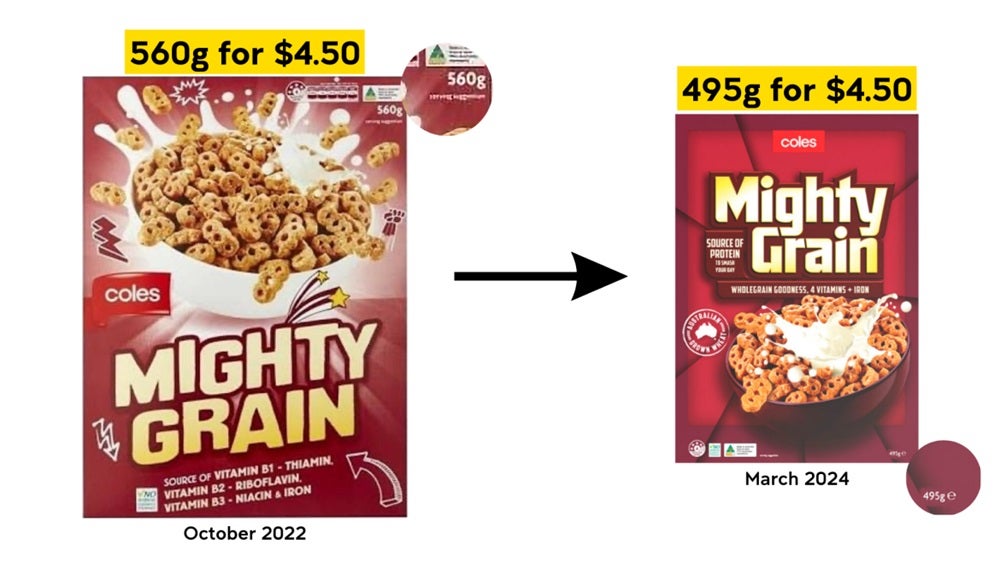Shrinkflation highlights costs of high inflation, weak competition
Retailers use shrinkflation and skimpflation to manage costs, which has sparked debate over fairness, competition and the rising cost of living
Claims of ‘skimpflation’ and ‘shrinkflation’ – covert retail tactics that pass higher costs on to customers – are creating tension between retailers and a consumer market still struggling with a high cost of living. The bigger picture is likely more complicated, though, as the key problem of inflation and other systemic issues force both sides to confront uncomfortable realities.
The latest Australian Bureau of Statistics (ABS) data shows increases of at least 1.2% in all five Living Cost Indexes in the June quarter, with annual increases of between 3.7% and 6.2%. Employee households experienced the strongest rises thanks to higher interest payments on mortgages, while the food and non-alcoholic beverages category was among the main contributors to the cost increases for all household types.
These tighter economic conditions have added to a growing spotlight on how retailers, especially in the supermarket sector, treat customers as they cope with their own cost pressures. For instance, shrinkflation – when a company reduces the size of a product without also reducing its price – has become a particular flashpoint, with the Albanese government recently announcing a strengthening of the unit pricing code in an explicit bid to tackle shrinkflation.
According to two experts from UNSW Business School – Professor Nitika Garg in the School of Marketing and Associate Professor Mark Humphery-Jenner in the School of Banking and Finance – these purported practices have a strong psychological impact on consumers, and ongoing high inflation is making them even more sensitive to perceived unfairness around costs and quality. Adding further to this tension, Australia’s biggest supermarkets have been at the centre of recent government scrutiny over a range of allegations, including price gouging, fake discounts and other unfair practices.
But the agreement, including the extent to which retailers use these tactics, largely ended there. Pushback against these purported practices and demands for more accountability are often overblown, according to A/Prof. Humphery-Jenner, who said any efforts to regulate against them would only exacerbate the underlying problems.
In contrast, Prof. Garg argued that retailers do use covert tactics like shrinkflation and that, at present, it’s up to the consumer to shop around them if they choose – so there is either a time or financial cost. She pointed to a lack of competition, including in the Australian supermarket “near-duopoly” of Coles and Woolworths, as a leading source of the problem and called for more assertive government intervention.
“Imagine a young family with young kids and without huge amounts of discretionary income,” she said. “How much time do they have to sit on websites and apps and price-compare? It is a heavy burden to place on individual consumers.”

Coles’ and Woolworths’ recent financial results haven’t helped their image, with Coles reporting $1.1 billion in profits for the year and Woolworths reporting a $108 million profit – down from $1.7 billion following a $1.5 billion impairment to its New Zealand business. Public backlash over high profits, particularly since the COVID-19 pandemic, prompted the Australian Competition & Consumer Commission in February to begin an investigation into the relationship between wholesale and retail prices in the supermarket industry.
But as Prof. Humphery-Jenner noted, the same inflation-based pressures making consumers more cost-sensitive are presenting significant challenges for retailers, most of whom are, in fact, facing “extremely thin” profit margins in the tougher economic landscape. Despite taking in high profits, supermarkets generally keep only a few cents for every dollar spent.
“The concern is that when customers are price sensitive – or demand elastic – retailers cannot maintain profits without losing customers; we are not even talking about increasing profits,” he said. “Operating at breakeven can be challenging when your own input costs go up and you cannot pass this on to customers.”
Understanding shrinkflation and skimpflation
There are common strategies retailers use to cope with increased input costs from high inflation, including through price control and customer-focused support actions. But reports have also emerged of retailers using less noble, more covert actions to pass costs on to customers, such as shrinkflation and skimpflation.
These terms refer to strategies that generally make it harder for consumers to gauge the value they’re getting for a purchase. For example, consumer group Choice has repeatedly found supermarkets engaging in shrinkflation in numerous products, including their own-brand breakfast cereals, charging consumers the same (or more) while covertly decreasing package sizes.

In a recent report, Choice found Coles selling Mighty Grain cereal in 495-gram packets for the same $4.50 price it charged for 560-gram packets in October 2022; the price for its Corn Flakes brand increased 20 cents to $2.10 in that time, despite the size shrinking from 475 grams to 440 grams. The same report found Woolworths downsizing its Max Charge cereal from 560 grams to 495 grams in September 2023 but leaving the price at $4.50 – a nearly 14% price increase for each 100 grams of cereal.
“Shrinkflation – where you get less for the same price – is probably the first line of defence that most retailers engage in – we know this from prior research and prior economic cycles,” Prof. Garg explained. “This is a covert tactic on the retailers’ and manufacturers’ side to shore up their bottom line when they are struggling,” she said, noting that shrinkflation involves the consumer behaviour theory of “just-noticeable difference”.
“When things become more expensive, they’ll reduce the quantity by just little enough to sneak under the ‘just-noticeable difference’ threshold, so people don’t realise they are getting less for the same price,” she added.
When faced with increased cost pressures, A/Prof. Humphery-Jenner said retailers often decide on either direct price hikes or indirect price hikes through shrinkflation, based on which option will likely prompt less backlash. “Often, shrinkflation creates less backlash as people do not realise that the price per unit has increased,” he said. “Or, if they do, they do not convert this directly into a price hike.”

Skimpflation refers to lowering the quality of a product or service without a corresponding price reduction, such as by selling food made with lower-quality ingredients or by reducing staffing levels at a restaurant. Prof. Garg said skimpflation can be particularly harmful because it’s harder to assess, especially when customers buy the generic home brand as a cost-saving measure.
“In those situations, if the quality is compromised or even just reduced, it is harder for the consumer to pick up on it,” she said.
The issue, according to A/Prof. Humphery, is that these tactics “look duplicitous”: “Customers might believe that companies are trying to deceive them about a price hike,” he said. “However, the converse is that those customers might also react negatively to a similar increase in price.”
Widespread inflation challenges
In a high-inflation context, retailers must also navigate the competing interests of maintaining customer loyalty and maximising shareholder value. A/Prof. Humphery-Jenner highlighted this challenging duality, noting that “without customers, there are no profits”.
Adding to this web of challenges is the difficulty in balancing thin profit margins against rising operational costs. “This is a common problem across almost all industries, whether it’s groceries, restaurants, small business or property,” he said, adding that, “despite being a political bogeyman”, even supermarkets have thin margins.
Read more: How are consumers and retailers responding to soaring inflation?
“The issue many retailers face is that profits are extremely thin,” he said. “For example, there are reports that a pub selling a $33 chicken parmigiana made only $2 profit per serving. Coles’ profit margin is around 2.5% and has been for a decade. “This places retailers and small businesses in a very difficult position,” he added.
Ultimately, the culprit for these problems is inflation, Prof. Humphery-Jenner stressed. “Retailers’ costs have increased; consumers’ disposable income has decreased,” he said. “This creates a downward spiral where consumers argue that they cannot afford to pay more, while retailers argue that they cannot afford to charge less.”
Deeper problems
Meanwhile, wages are also falling in real terms, meaning employees are likely to “impose their own shrinkflation or skimpflation vis-à-vis their employer or the customers”, such as by working less hard, Prof. Humphery-Jenner said. “Thus, shrinkflation and skimpflation permeate the whole supply chain, from suppliers to retailers to employees,” he said.
Nonetheless, with limited competition in the supermarket sector, consumers find themselves questioning the fairness of rising prices and reduced product sizes in a marketplace that often feels rigged against them.
As Prof. Garg noted, price pressures often stem from an industry shock, as happened with dairy in recent years when prices jumped almost overnight. However, “that shock has since subsided and been digested in the supply chain; the supply chain has stabilised, but the prices have not come down”, she said. “Because, for the retailers, if the consumer is now already used to paying, let’s say, more than $1 a litre for milk, that’s fine; why should they bring it down?”

To Prof. Garg, a significant contributor to these problems in Australia is a lack of competition in too many markets. “If people really want to get the best deal for them and make a difference to their budgets, at least, and hopefully send a message to these companies in the long run, they have to shop around, which obviously carries a cost for consumers,” she said.
“When such a huge section of the population is struggling, this requires more systemic changes and for us to rethink why our markets are designed the way they are,” she said. “Why is the competition so limited in Australia, and what can we do to address it without compromising the quality people get?”
She pointed to the investigations into Coles and Woolworths as a sign that the government might be taking a more assertive role. “That’s obviously what we as consumers expect from government representatives – that they are going to take this on for us,” Prof. Garg said.
“It shouldn’t be up to the individual consumer,” she added. “That’s where governance comes in: the government or regulatory bodies need to step in because this is not something the individual consumer can do too much about – especially in Australia, where the competition is so limited.”
Read more: Supermarket tricks to watch out for as cost of living soars
But Prof. Humphery-Jenner countered that incoming regulations will only exacerbate the problems, with more complex industrial relations laws adding to salary costs as well as indirect compliance costs. It means that there are significant barriers to entry for a startup or a small business trying to compete. In some areas, margins are also thin, meaning that the market might simply not be able to support more players.
Avoiding the backlash
To the extent companies have a solution to these tensions, A/Prof. Humphery-Jenner said, several strategies might help offset perception issues and other headaches from shrinkflation and skimpflation backlash, depending on the nature of the business.
For instance, companies can use clever marketing or “gamified” discounting methods to create a perception of value, or they may incentivise staff to improve performance, such as through commissions. For example, a 10% chance of a free product is more attractive than a 10% discount, and that one-in-10 chance of a freebie can encourage people to increase their basket size.
“In so doing, commissions and bonuses can both enhance employee morale and loyalty and drive sales,” he said. “This is important because many companies lack such a mechanism, leading to employees being indifferent towards margins, revenue or sales growth.”
A/Prof Humphery-Jenner also said companies should better explain to customers the issues underlying perceived high prices. “Customers might complain about that $33 chicken parmigiana, but those complaints are neutralised if they realise that the company is not earning much per meal,” he said.
Subscribe to BusinessThink for the latest research, analysis and insights from UNSW Business School
Prof. Garg said any solution to the competition problem must involve a multi-pronged strategy, but that the most common-sense solution is to open markets up and make it easier for newcomers to compete. When there is competition, the market can better adjust to price pressures. “Right now, we don’t have that option, and that’s the most self-correcting market-based policy,” she said. “Why are we acting almost like a protectionist society here, where we’re not letting competition in?”
A/Prof Humphery-Jenner noted that some regulatory changes are in fact worsening the lack of competition in some spaces, saying the Australian Securities and Investments Commission’s proposal to change the definition of ‘wholesale’ investors in the financial services industry would effectively make it harder for new funds to raise capital. In so doing, it would undermine competition in the fund management space and entrench dominant players.
He noted that even well-intentioned regulations can increase costs, especially for startups and new entrants. Measures such as price controls or onerous price scrutiny would only make that worse.
Prof. Garg highlights that retailers can take steps to help consumers struggling with high living costs, such as by partnering with government programs supporting vulnerable populations and young families. “They say they are here for the communities, and that’s how they build their reputation and relationship with consumers,” Prof. Garg said. “I think they’re missing an opportunity to do something. And they can do it.”
